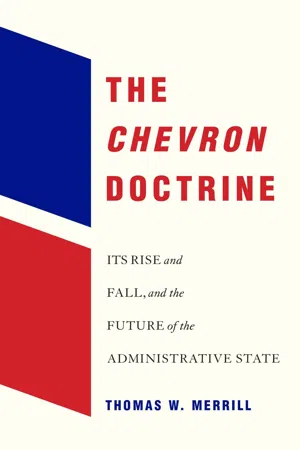
The Chevron Doctrine
Its Rise and Fall, and the Future of the Administrative State
- English
- PDF
- Available on iOS & Android
About this book
"Wise and illuminating…Merrill's treatment of the rise of Chevron, and its various twists and turns over the decades, is keenly insightful." —Cass R. Sunstein, New York Review of Books
"Merrill is one of the brightest and best scholars of administrative law in his generation. This book...is must-reading for any citizen who has an interest in the constitutionality of the administrative state." —Steven G. Calabresi, Northwestern University Pritzker School of Law
"A model of how to conduct rigorous, level-headed, and fair-minded analysis of a subject that has generated enormous legal controversy. There is no more judicious mind among American legal scholars than Thomas Merrill's."—Nicholas Parrillo, Yale Law School
"A must-read for practicing or prospective administrative lawyers. They, as well as a broader audience, will find much good sense in the author's judicious treatment of perennial questions of lawful government."—Michael S. Greve, Claremont Review of Books
The Constitution makes Congress the principal federal lawmaker. But for a variety of reasons, including partisan gridlock, Congress increasingly fails to keep up with the challenges facing our society. Power has shifted to the executive branch agencies that interpret laws and to the courts that review their interpretations.
Since the Supreme Court's 1984 decision in Chevron v. Natural Resources Defense Council, this judicial review has been highly deferential: courts must uphold agency interpretations of unclear laws so long as these are "reasonable." But the Chevron doctrine faces backlash from constitutional scholars and, now, from Supreme Court justices who insist that courts, not administrative agencies, have the authority to say what the law is. Critics of the administrative state charge that Chevron deference enables unaccountable bureaucratic power. In this groundbreaking book, Thomas Merrill reviews the history and consequences of the Chevron doctrine and suggests a way forward.
Frequently asked questions
- Essential is ideal for learners and professionals who enjoy exploring a wide range of subjects. Access the Essential Library with 800,000+ trusted titles and best-sellers across business, personal growth, and the humanities. Includes unlimited reading time and Standard Read Aloud voice.
- Complete: Perfect for advanced learners and researchers needing full, unrestricted access. Unlock 1.4M+ books across hundreds of subjects, including academic and specialized titles. The Complete Plan also includes advanced features like Premium Read Aloud and Research Assistant.
Please note we cannot support devices running on iOS 13 and Android 7 or earlier. Learn more about using the app.
Information
Table of contents
- Cover
- Title Page
- Copyright
- Dedication
- Contents
- Introduction
- 1. Judicial Review of Agency Interpretation—Four Values
- 2. Before Chevron
- 3. The Chevron Decision
- 4. The Rise of the Chevron Doctrine
- 5. The Indeterminacies of the Chevron Doctrine
- 6. The Domain of the Chevron Doctrine
- 7. Rule of Law Values
- 8. Constitutional Avoidance
- 9. The Preemption Puzzle
- 10. The Principle of Legislative Supremacy
- 11. Discerning the Boundaries of Agency Authority to Interpret
- 12. Improving the Quality of Agency Interpretations
- 13. Reforming the Chevron Doctrine
- Concluding Thoughts
- Notes
- Acknowledgments
- Index